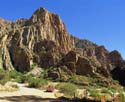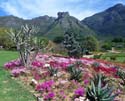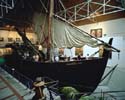 |
Great Cape Town Tours
|
|
|
|
 |
|
|
|
|
Shorter Garden Route Tour
Specially for Those Short on Time!
For
you if time is short - the Shorter Garden
Route tour is a great solution...
Now
have the opportunity with this tour to
enjoy many Garden Route Highlights within
3 days. The Garden Route tour start with
a drive on N1, through the Little Karoo
and winds through the spectacular Swartberg
Mountain Pass. From Oudtshoorn it's down
to Knysna and back to Cape Town along
the coast.
SHORT GARDEN ROUTE TOUR DETAILS
Distance: 1 480 km / 925 miles
Duration: 3 days
Best time: All year
Included: Certified driver/guide,
a/c vehicle and gasoline
Excluded: Entrance fees, overnight accommodation, lunch,
drinks
Price: Please request a quote
Note: All tours can be customized
 Inquire
about the Shorter Garden Route
Tour
Inquire
about the Shorter Garden Route
Tour
-
Short Garden Route Tour -
DAY
1
 1.
CITY BOWL 1.
CITY BOWL
The Short Garden Route Tour starts in Cape
Town's city centre which lies cradled in
a vast blue-grey amphitheatre formed by
Table Mountain, Lion's Head and Devil's
Peak. This conglomeration of Dutch and Victorian
architecture, interspersed with modern wonders
of glass and concrete, is the heart of Cape
Town and on either side of Adderley Street
is an eclectic array of sightseeing highlights
and urban attractions that endowed the Mother
City with its unique flavour.
 2.
DU TOIT'S KLOOF PASS 2.
DU TOIT'S KLOOF PASS
The scenic route between Worcester leads
through the Breede River Valley and flanked
by vineyards that is bush green during spring
to summer and a kaleidoscope of colours
during high autumn. The route winds through
the Du Toit's Kloof Mountains and is occasionally
covered with snow during winter. The effect
of these majestic mountains will stay with
you for a long time to come.
 3.
WORCESTER 3.
WORCESTER
Worcester ‘capital of the Breede River Valley'
was founded, developed and granted municipal
status in 1842. The town is the commercial,
distribution and transport center for the
district. Five major roads including the
N1 radiate in all directions. Kleinplasie
(“little farm”) is a living open-air agricultural
museum with a full range of period farmyard
buildings. Visitors receive a glimpse of
the pioneering days of farming when farmers
had to be self-reliant or go under.
 4.
HEX RIVER VALLEY 4.
HEX RIVER VALLEY
From the very first days one of the major
routes to the north lay through the Hex
River valley. Very scenic and picturesque
specifically during autumn with its kaleidoscope
of colours gives the visitor sheer pleasure
driving through the valley. The road was
upgraded in the 1860's after Second World
War.
 5.
MATJIESFONTEIN 5.
MATJIESFONTEIN
Matjiesfontein was established in 1883 by
James Douglas Logan as a health resort.
It was the first village in South Africa
to have electricity and water-borne sewerage.
Matjiesfontein is rich in history. 12 000
British soldiers were stationed here during
the Anglo Boer-War.
 6.
LAINGSBURG 6.
LAINGSBURG
Laingsburg was established 1881 and was
named for John Laing, Commisioner of Crown
Lands at the time. The main economic activity
is wool production but limited quantities
of lucern and deciduous fruit are also grown
under irrigation. The town was almost washed
away during the flashfloods in 1981.
 7.
PRINCE ALBERT 7.
PRINCE ALBERT
Prince Albert is nestled quietly at the
foot of the majestic Swartberg Mountains.
Prince Albert was established as early as
1842 on one of the farms in the district
and later in honour of the Prince Consort.
The name was later changed. Gold was dug
up here during the gold rush in 1890. Deciduous
fruit is grown under irrigation in the town
and district.
 8.
SWARTBERG PASS 8.
SWARTBERG PASS
The Swartberg Pass over the mountain by
the same name, was built by Thomas Bain,
master pass builder to link the Little and
Great Karoo. Just a few kilometers outside
Prince Albert the visitor encounters the
stunning entrance to this majestic pass
and simply has to stop and appreciate nature
before continuing. On the crest of the mountains
explicit scenes of nature awaits those who
dare to travel the pass. This is a highlight
on the Garden Route tour.
 9.
CANGO CAVES 9.
CANGO CAVES
The Cango Caves with their dripstone creations
are universally regarded as one of South
African's greatest natural wonders. These
stalactites (hanging crystals), stalagmites
(those growing upwards) and helictites (those
growing in any direction) began to be formed
about 100 million years ago in crystalline
limestone along an old fault line in the
foothills of the Swartberg range. Guided
tours of the caves can be undertaken and
lasts 1 hour.
 10.
OSTRICH FARM 10.
OSTRICH FARM
Oudtshoorn is the only district in South
Africa where the world's largest flightless
bird is commercially farmed on a large scale.
A tour on one of the show farms can be undertaken
and last 1 hour. It includes a ride on the
birds for the more adventurous. You'll won't
forget this on your Garden Route tour.
 11.
OUDTSHOORN (CITY TOUR) 11.
OUDTSHOORN (CITY TOUR)
The town was proclaimed in 1863 and named
for Baron Pieter van Rheede van Oudtshoorn.
He tragically died at sea in 1773 en route
to the Cape to take up his appointment as
governor. Oudtshoorn is the ostrich capital
of the world. Several “feather palaces”
was built as a result of the feather boom.
Oudtshoorn is the venue for the Little Karoo
arts Festival.
12. (OVERNIGHT STAY: OUDTSHOORN
- GARDEN ROUTE TOUR)
DAY 2
 13.
OUTENIQUA PASS 13.
OUTENIQUA PASS
Construction of the Outeniqua Pass, a modern
expressway was started in 1943 and opened
on 20 September 1951. The pass rises at
a steady rate outside of George to reach
the summit (800 meters) 14km later. It is
just a sheer driving pleasure to travel
on this road with exquisite views over the
coastal belt and onto the Little Karoo on
the other side. Viewpoints give opportunity
to absolute photo stops.
 14.
GEORGE 14.
GEORGE
A woodcutters past was already established
here in 1776 to organize the felling of
timber in the mountains. George Town was
proclaimed on 23 April 1811 and the first
new district in the colony under British
control. The name honoured the monarch at
the time, George III. The actual “Garden
Route” starts here and in those days with
all the forests and their fynbos undergrowth
intact, the sobriquet "Garden of Eden" would
not have been inappropriate at all. Mixed
farming and timber are the main source of
income.
 15.
KNYSNA 15.
KNYSNA
Knysna is the ideal base to explore the
Garden Route and its history is woven around
its rich natural heritage: the indigenous
forests. George Rex is considered to be
the founder of Knysna in 1804. It lies on
the banks of a tranquil lagoon, guarded
at its mouth by The Heads, and overlooked
to the north by the Outeniqua Mountains.
 16.
KNYSNA LAGOON BOATTRIP (OPTIONAL) 16.
KNYSNA LAGOON BOATTRIP (OPTIONAL)
A number of ferry trips around the Waterfront
are available daily, weather permitting.
Some companies offers trips on the Lagoon
and beyond the head and others for sundowner
trips on the Lagoon visiting the Nature
Reserve where the Knysna Loerie, Blue Duiker
(smallest antelope) and sea horse can be
seen.
 17.
KNYSNA HEADS 17.
KNYSNA HEADS
There is no certainty to the meaning of
the word of Khoisan origin. One source suggested
it is a corruption of the two words meaning
“straight down” a reference to the two cliffs
at the entrance to the harbour, now known
as the Heads. The Eastern Heads viewpoint
offers a panoramic view of the town, the
estuary and the Indian Ocean.
 18.
GARDEN OF EDEN 18.
GARDEN OF EDEN
The Garden of Eden offers walks ranging
from easy to difficult and from short to
long through the Knysna Forest. The walking
route in the Garden of Eden is wheelchair
friendly. The forest can be entered at any
time during the day but its best to leave
before sunset. South Africa's National tree:
Yellow wood and other indigenous trees like
the Ironwood, Stinkwood, Milkwood and many
others can be seen.
19. (OVERNIGHT STAY: KNYSNA - GARDEN
ROUTE TOUR)
DAY 3
 20.
SEDGEFIELD 20.
SEDGEFIELD
Sedgefield takes its name from the many
large patches of sedge in the neighbourhood
and was established in 1928. This was the
year when the railway from George to Knysna
was completed. The road through Sedgefield
passes between bush-covered sand dunes on
the seaside and the lakes, some forest-fringed,
with superb vistas on the mountains. Sedgefield
is a quaint little town for people in love
with nature.
 21.
WILDERNESS 21.
WILDERNESS
Wilderness, village and resort, is located
on the mouth of the Touws River. Hippopotami
use to wallow here in the early days. The
resort's name is rooted in its traditional
popularity as a honeymoon destination. A
number of view-sites are provided to drink
in the beauty of nature, watching dolphins and
whales.
 22.
MOSSEL BAY 22.
MOSSEL BAY
Mossel Bay has a strong association with
the early Portuguese navigators of the 15th
and 16th centuries. Bartholomeu Diaz sailed
on 3 Feb 1488 into the bay and replenished
his supplies of water. Other explorers used
the same spring too for the years to come.
Mossel Bay is South Africa's 7th largest
port and boasts the first “post-office”
and church in the country. Legend has it
that the Dutch navigator Paulus van Caarden
entered the bay in 1601 and found nothing
else than mussels to replenish his supplies
and from there the name.
 23.
DIAZ MUSEUM COMPLEX 23.
DIAZ MUSEUM COMPLEX
The Mossel Bay Museum Complex has recently
been upgraded and displays a rich cultural
history. The old “post-office” tree, inaugurated
by D'ataide, and the fountain which supplied
many vessels are now national monuments.
A letterbox in the shape of a Portuguese
seaman's boot is placed in 1963 by the Post
Office and letters can be posted here. In
the maritime museum is the prize exhibit
of the caravel built in Portugal and suited
to South Africa in 1988 to mark the 500th
anniversary of Diaz's “discovery” of the
bay in 1488.
 24.
SWELLENDAM 24.
SWELLENDAM
Swellendam is the 3rd oldest town after
Cape Town and Stellenbosch. Swellendam was
established in 1745 as sub-magistracy. For
a few months in 1795 Swellendam was a “national
capital” when the locals dismissed the landdrost
(magistrate) and declared Swellendam a new
colony, independant of the VOC (Dutch East
India Company). The town was named for Governor
Hendrik Swellengrebel and his wife Helena
ten Damme. Swellendam is recorded as the
cradle of South Africa's merino sheep farming
industry. The Drostdy which served as a
seat of the magistrate for over 100 years
until 1846 is now a cultural history museum
and one of the country's great architectural
treasures.
 25.
CALEDON 25.
CALEDON
The name of the town was changed in 1813
to Caledon in honour of a former governor
of the Cape, the Earl of Caledon. Agriculture,
timber and wool are the main economic activities.
Caledon boasts the largest malt-producing
plant in the Southern hemisphere. The world-famous
Caledon wildflower Garden and Nature Resereve
was established 1899. The Caledon district
hosts also out national bird, the Blue Crane.
 26.
HERMANUS (WHALES DURING SPRING) 26.
HERMANUS (WHALES DURING SPRING)
Hermanus is one of the world's finest holiday
and fishing resorts and also the best land
based whale-watching place. The town is
named after Hermanus Pieters and the first
municipality proclaimed in 1904. An official
whale crier, complete with uniform and horn,
announces the arrival of the gentle giants
of the deep mostly Southern Rights. There
are many viewpoints to watch them from winter
to spring. The giant marine mammals enter
the bays both to mate and, after a yearlong
gestation period, to calve.
 27.
BETTY'S BAY 27.
BETTY'S BAY
Betty's Bay was named for the daughter of
Arthur Youlden in the 1930s. Together with
two other businessmen of Johannesburg, they
developed the seaside in the municipality.
The African Penguin lives at Stony Point
and a visit will be worthwhile. The Herold
Porter National Botanical Garden in and
around Disa Kloof represents one of the
largest concentrations of wild flower species
in the country and has an entrancing waterfall.
 28.
GORDON'S BAY 28.
GORDON'S BAY
Tucked into a secluded corner of False Bay,
this holiday village has a small harbour
and is a popular angling and boating resort.
It takes its name from Colonel Robert Gordon,
commander of the garrison at the Cape from
1780 to 1795. A beautiful marine scenic
drive (Route 44) extends from Gordon's Bay
to Hangklip, a 454 m high ‘hanging' chunk
of rock that marks the easternmost end of
the False Bay. After Gorden's Bay we return
to Cape Town on this short Garden Route
Tour.
for
more possibilities Top
14 - Cape Town tour recommendations
|
|
|
|
|
|
 |
 |
 |
 |
 Contact
Us Contact
Us
©2000 - 2016 Meljo
Tours, All rights reserved, useful
links
Johnny Maasdorp - Cape Town - South Africa - +27(0)82
8204946
|
|
|
|
|